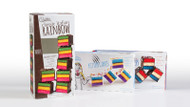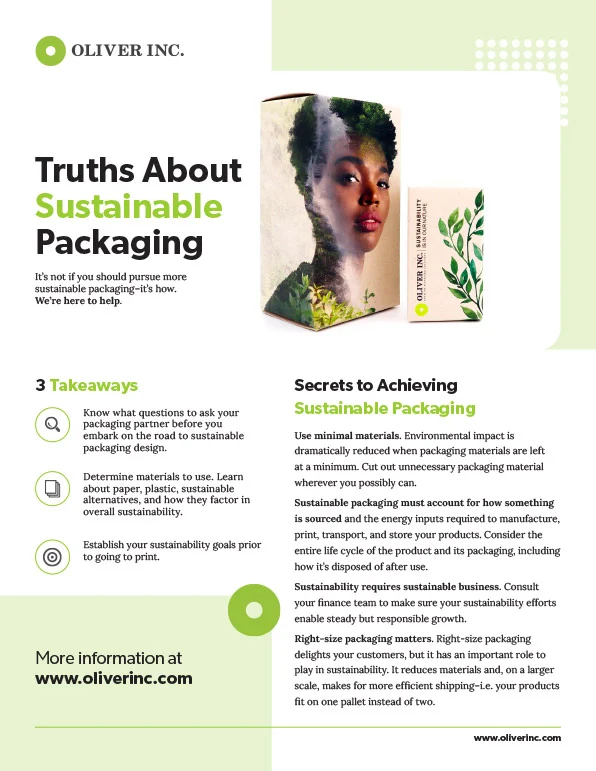The Top Considerations in Food Packaging
Posted by Oliver Inc. on 6th Apr 2023
As a food manufacturer, you need to deliver effective packaging for your products in an ever-changing industry. Consumers are shopping in different ways, not just in grocery stores but online, as well.
So how do you reach them in these different settings, especially with so many options at their disposal?
It requires a holistic and synergistic approach. Consider all aspects of your food packaging, from the branding possibilities and maximizing shelf presence, to providing protection, and promoting sustainability.
By focusing on each, you can produce packaging that demonstrates high quality and communicates to the customer the value of what's inside at affordable prices.
Here are the top considerations in food packaging.
Eye-Grabbing Packaging That Elevates Your Brand
Food packaging often mimics similar products within a category, but it should be unmistakably yours.
Think of it this way: The carton is your billboard. With cars flying by on the highway, companies know they have to appeal to potential customers quickly. That’s also true on crowded grocery store shelves and in online settings, with consumers scrolling through options. Packaging should grab their attention and elevate your brand.
You can achieve this in different ways. In general, food manufacturers take a straightforward approach to showcase their brands. They often rely on simple touches, such as a minimalist logo on smooth paperboard, instead of more complex decorative effects (foil stamping, embossing/debossing, and specialty laminates) to deliver a clear message while remaining cost effective.
Your food packaging should feature the following qualities as they relate to branding:
- Authentic – Keep brand and packaging design consistent.
- Versatile – Make the packaging adaptable and flexible to compensate for additional flavors or versions.
- Clear – Keep the messaging simple and to the point.
In total, your goal is to appeal to the consumer while conveying exactly what’s inside.
There’s another component as well. The materials used should also speak to your brand. For example, if you package ‘healthy-alternative’ or ‘green’ items, consider sustainable paperboard alternatives.
There’s a lot that goes into sustainable packaging design, but it’s worth considering, given the increasing number of consumers willing to pay more for more environmentally friendly packaging and products—and vital, if sustainability is part of your brand.
View this post on Instagram
Maximize Shelf Presence
Yes, branding is an important part of the design process, but it’s not the only component.
The physical dimensions, composition, and aesthetics of innovative packaging can boost the product’s sales potential. When the two elements are combined—branding and innovative packaging—you maximize shelf presence to potentially great effect.
Consider Williams Sonoma’s line of coffee capsules. The packaging features the elegance we’ve come to expect from the kitchen retail giant while highlighting the products themselves. There’s another touch, as well. The outline of the capsules on the folding cartons demonstrate to the consumer, whether they're in the aisle or shopping online, that this is a sleek design that uses just the right amount of space.
That's a vital effect for an industry (single-use coffee capsules) that's struggled with sustainability.
The packaging makes the most of its materials, allows for decorative effects and appropriate branding, and communicates a clear message to the consumer to maximize shelf presence.
Protective Packaging That Preserves
Protective packaging goes beyond preventing spills or breaks. Of course, if a box of rice falls off a shelf you don’t want hundreds of grains to splay out across the floor, and sturdy, well-designed folding cartons are crucial for that reason.
You should be more concerned about maximizing shelf life (including for frozen foods). As soon as most food products hit the shelves, their biological clocks start ticking. Effective packaging should prolong its contents’ quality.
For now, you’ll most likely rely on plastics to do that, although manufacturers are developing sustainable options (such as casein protein) without sacrificing quality. It’s a solution that’s valued by producers and consumers alike.
Work With an SQF-Certified Manufacturer
No food company desires to be included in the U.S. Department of Agriculture's roster of recalls and public health alerts due to the significant costs, including millions of dollars, potential legal fees, and reputational damages caused by the viral spread of negative headlines.
However, you can take precautions to lessen the likelihood of a recall, such as implementing safety practices at your own facilities and collaborating with manufacturers who prioritize safety.
One effective measure is to partner with an SQF-certified packaging manufacturer, which guarantees that your packaging supplier adheres to the most stringent global food safety standards.
Established in 2000, the Global Food Safety Initiative (GFSI) aims to address food safety issues worldwide and increase consumer trust in food safety management practices. Instead of creating its own safety certifications, GFSI endorses independent agencies called 'certification program owners' (CPOs) that comply with its set standards.
One such CPO is Safe Quality Food (SQF), which assures customers that food manufacturers' processes align with the highest global safety standards. SQF certification covers industry, regulatory, and customer requirements for all supply chain sectors, from farm to fork. The SQF Food Safety Program is divided into six codes: primary production, food retail, manufacturing, food packaging, storage and distribution, and quality.
Put simply, implementing food safety measures such as SQF is a crucial step to safeguarding your brand and customers.
Sustainable Packaging
Sustainability is a hot topic in the food industry. Foods that outlast expiration dates get tickets to the landfill.
The entire life cycle of a product is tied to sustainability, making it a ‘sticky’ issue. The behavior can be sustainable—you only work with responsibly sourced materials and run on green energy. The packaging itself could be recyclable, but as soon as it mixes with waste and consumers are forced (or choose) to throw it away, it’s garbage.
There are ways companies have improved their green efforts without sacrificing the integrity of their products. Think of this in terms of the aforementioned categories:
Branding - Companies can feature certification logos (such as the Forest Stewardship Council (FSC) designation for paperboard made from pulp harvested from responsibly managed forests), post-use instructions, and/or information on where they sourced raw materials from to showcase their sustainability efforts.
Maximizing Shelf Presence - Focusing on an innovative design includes shifting from plastics to paperboard solutions.
Protective Packaging - Print companies are developing paper-based solutions that maintain shelf-life as manufacturers ask about moving away from plastic.
Even if you can’t eliminate single-use products, you can still invest in sustainability. It comes down to viewing your packaging as more than packaging, which only aids your sales efforts.
That’s true in any industry, but especially with food. The right partner can help achieve your packaging goals and elevate your brand, while offering budget-friendly solutions.






